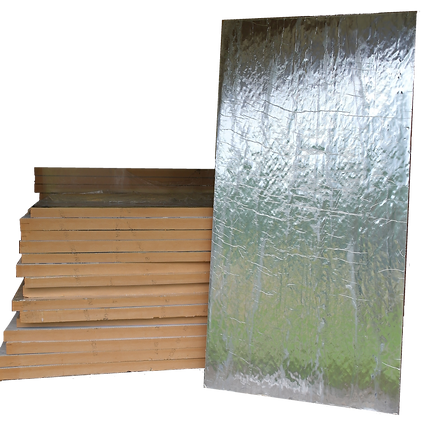
rigid insulation
Rigid insulation board is used in all sorts of construction to insulate and provide the needed R-vaule for a structures wall, ceiling, or floor assembly. It is conducive to certain types of substrates and cladding materials and many advances have been made over the last several decades in it’s production and performance. Some different properties that can be expected from rigid insulation are: R-Value (thermal resistance), compression/denting/mold/decay/heat/fire resistance, etc. Unfortunately no sole material contains all of these characteristics. Rigid insulation boards can come with square edges or tongue-and-groove edges.



Also, tapered rigid insulation board is available premanufactured and is very commonly used under roofing materials to achieve the desired slope for roof drainage.

The following are the different types of rigid insulation, their properties, and advantages/disadvantages.
Expanded Polystyrene Foam (EPS)
EPS rigid foam is a closed cell, typically unfaced (somewhat fragile and semi-permeable), highly versatile, mold manufactured material. It’s often used on wall framing, roof decks, around foundations, and under concrete slabs on grade. It’s typical R-Value is 3.6 – 4.6 per inch. and it will combust under high heat but will typically self-extinguish. Vapor permeable but will seal well against leakages of air. EPS foam is commonly less expensive than extruded polystyrene foam but is less suitable for some particular applications such as: incompatibility with hot bitumens, higher moisture absorption rate. EPS can be used in contact with the earth but long term exposure to UV rays will begin to damage and breakdown the materials properties. EPS is very commonly used in insulated concrete forms and structural insulated panels. EPS has the lowest of R-Values of the major types of rigid insulation coming in around R3.6 – R4.6 per inch. EPS board typically comes in sheet sizes of 4′ x 4′, 4′ x 90″, 4′ x 8′, and 4′ x 10′. Available thicknesses for square edge are 1/2″, 3/4″, 1″, 1-1/2″, and 2″. Common compression strengths are 10psi, 15psi, 20psi, 25psi, 30psi.



Extruded Polystyrene Foam (XPS)
XPS rigid foam is a closed cell, typically unfaced (somewhat fragile and semi-permeable), highly versatile, extruded manufactured material.
It’s often used on wall framing, roof decks, around foundations, and under concrete slabs on grade. It’s typical R-Value is +/- 5 per inch of material and it will combust under high heat but will typically self-extinguish. XPS foam is commonly more expensive than expanded polystyrene foam because of it’s suitability with hot bitumens at lower temperatures, higher compressive strength, lower moisture absorption rate, and slightly better R-value per inch. It can also come with a number of different plastic facings adding to its vapor and moisture resistant characteristics, but it is still only considered a vapor retarder not a vapor barrier.
XPS can be used in contact with the earth but long term exposure to UV rays will begin to damage and breakdown the materials properties. Also it is more susceptible to moisture long term than EPS, which typically degrades it’s R-value over time making many manufacturers reluctant to warrant the material. XPS is also commonly used in insulated concrete forms and structural insulated panels. because of it’s superior characteristics over expanded foam, it is often used on roofs and other higher traffic, higher moisture areas. XPS’ R-Value may decrease some over time as the material ages. It has moderate fire resistance characteristics.
XPS is commonly blue, green, or pink in color. The most commonly used board size is 4′ x 8′ but the follwing may be available as well: 16″ x 8′, 2′ x 8′, 4′ x 8′, or 4′ x 9′. Available thicknesses for square edge are typically: 3/4″, 1″, 1-1/2″, 2″, 2-1/2″, 3″, 3-1/2″, 4″. Common compression strength ranges are from: 15psi, 25psi, 40psi, 60psi
Polyisocyanurate (ISO)
ISO foam is a closed cell rigid insulation made of polyisocyanurate foam board with a facing material (aluminum foil, glass-fiber mats, or cellulosic mats). It is most commonly used as roof insulation because of it’s compatibility with hot bitumens, but is also used as wall insulation. It’s R-Value range of 5.6 – 6.5 for 1″ of material is the highest of the primary rigid insulation types, hence it’s highest cost. Like XPS, it too can succumb to reduced R-Value over time as it ages and breaks down. Foil-faced boards are impermeable, and should not be used in conjunction with an interior vapor barrier. Board sizes are typically available in 4′ x 4′ and 4′ x 8′. Available thicknesses are 1″, 1.5″, 2″, 2.5″, 3″, 3.5″, 4″.

Glass Mat

Foil Faced Mat
